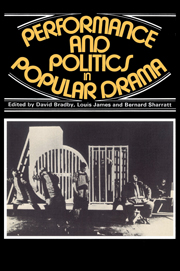 Performance and Politics in Popular Drama
Performance and Politics in Popular Drama Book contents
- Frontmatter
- Contents
- List of contributors
- Preface
- Acknowledgements
- PART ONE Spectacle, performance and audience in nineteenth-century theatre
- Introduction
- Was Jerrold's Black Ey'd Susan more popular than Wordsworth's Lucy?
- Word and image in Pixérécourt's melodramas: the dramaturgy of the strip-cartoon
- Joseph Bouchardy: a melodramatist and his public
- The music of melodrama
- Popular theatre in Victorian Birmingham
- Water drama
- Equestrian drama and the circus
- Theatre of war: the Crimea on the London stage 1854–5
- Popular drama and the mummers' play
- PART TWO Politics and performance in twentieth-century drama and film
- PART THREE Problems and prospects
- Appendix: Tempo, Tempo
- Select bibliography
- General index
- Index of titles of plays, films, sketches
- Index of theatres, theatre companies and groups
Popular theatre in Victorian Birmingham
Published online by Cambridge University Press: 08 March 2010
- Frontmatter
- Contents
- List of contributors
- Preface
- Acknowledgements
- PART ONE Spectacle, performance and audience in nineteenth-century theatre
- Introduction
- Was Jerrold's Black Ey'd Susan more popular than Wordsworth's Lucy?
- Word and image in Pixérécourt's melodramas: the dramaturgy of the strip-cartoon
- Joseph Bouchardy: a melodramatist and his public
- The music of melodrama
- Popular theatre in Victorian Birmingham
- Water drama
- Equestrian drama and the circus
- Theatre of war: the Crimea on the London stage 1854–5
- Popular drama and the mummers' play
- PART TWO Politics and performance in twentieth-century drama and film
- PART THREE Problems and prospects
- Appendix: Tempo, Tempo
- Select bibliography
- General index
- Index of titles of plays, films, sketches
- Index of theatres, theatre companies and groups
Summary
In St Paul's Square in Birmingham, during the 1840s, there was a rule-making workshop, where one Dyke Wilkinson and his fellow apprentices would often divert their master's ivory from its ordained function to the clandestine fashioning of dice. The subsequent sale of these dice was a useful source of pocket-money, ‘generally spent’, said Wilkinson, ‘on sixpenny seats in the gallery of the old Theatre Royal’.
It is from such fragments of evidence that a picture of workingclass theatre-going in mid-nineteenth-century provincial England may be constructed. The subject forms a significant but unexplored aspect of the history of theatre and of working-class culture, and it is a major objective of this paper to establish systematically some of the dimensions of this area. Who went to the theatre? When did they go? Where did they sit? What plays were most popular? How were they received? The inquiry will be structured around the Birmingham Theatre Royal from the 1840s to the 1870s, a period chosen because it has both a theatrical and social coherence; occasionally, however, where evidence is available, the questions will be extended to other theatres.
When entering new territory a reconnaissance photograph is always useful, and so it will be desirable here to anticipate our conclusions somewhat. The evidence demonstrates that the pit and gallery of the theatre in early- to mid-Victorian Birmingham were largely peopled from the working class – a term which is used here in an umbrella, descriptive capacity, encompassing a significantly varied social reality. The most popular types of play are seen to have been melodrama – no surprise to the received assumptions about the period – and Shakespeare – a very much unappreciated historical fact.
- Type
- Chapter
- Information
- Performance and Politics in Popular DramaAspects of Popular Entertainment in Theatre, Film and Television, 1800–1976, pp. 65 - 90Publisher: Cambridge University PressPrint publication year: 1980
- 2
- Cited by
